Organizational Change Management: Culture Impact Analysis Essay
VerifiedAdded on 2021/04/17
|8
|3056
|31
Essay
AI Summary
This essay delves into the complexities of organizational change management, examining the influence of culture and power dynamics. It begins by outlining the framework of organizational change management and highlighting the importance of power in initiating and driving change. The essay then provides a concise overview of Hofstede's cultural dimensions, specifically focusing on Singapore and Australia, analyzing aspects such as power distance, individualism, masculinity, uncertainty avoidance, long-term orientation, and indulgence. It contrasts the cultural landscapes of these two countries, illustrating how these dimensions shape organizational practices. Furthermore, the essay explores the five bases of power (legitimate, reward, expert, referent, and coercive) and their implications for change management. It argues that the effective use of power is contingent upon the cultural context, with different types of power being more or less suitable depending on a society's cultural values. The essay concludes by emphasizing the crucial interplay between culture and power in successful organizational change initiatives, suggesting that organizations must align their change strategies with the prevailing cultural norms to achieve optimal outcomes. This analysis provides valuable insights into how organizations can navigate the challenges of change management by understanding and leveraging cultural dynamics.
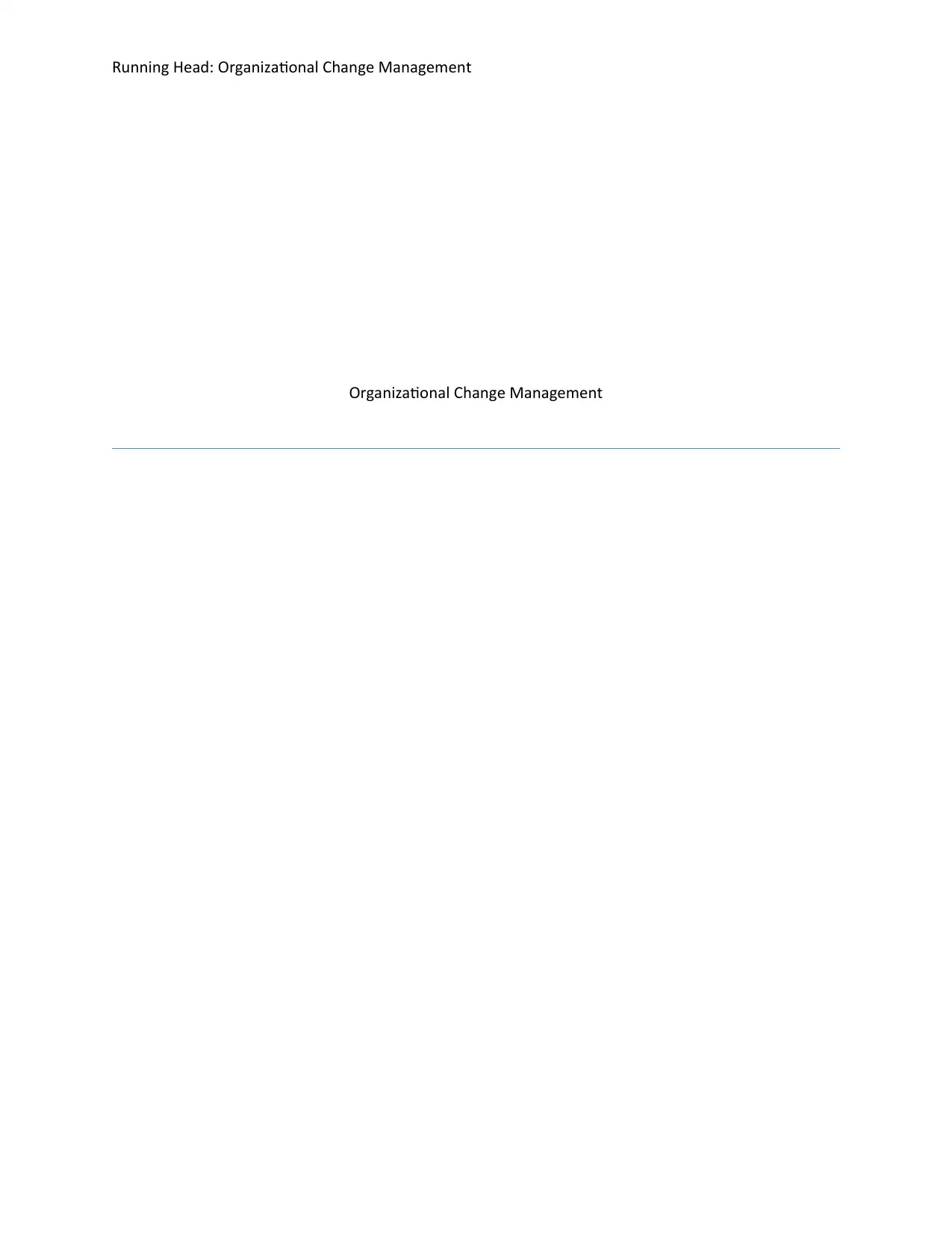
Running Head: Organizational Change Management
Organizational Change Management
Organizational Change Management
Paraphrase This Document
Need a fresh take? Get an instant paraphrase of this document with our AI Paraphraser
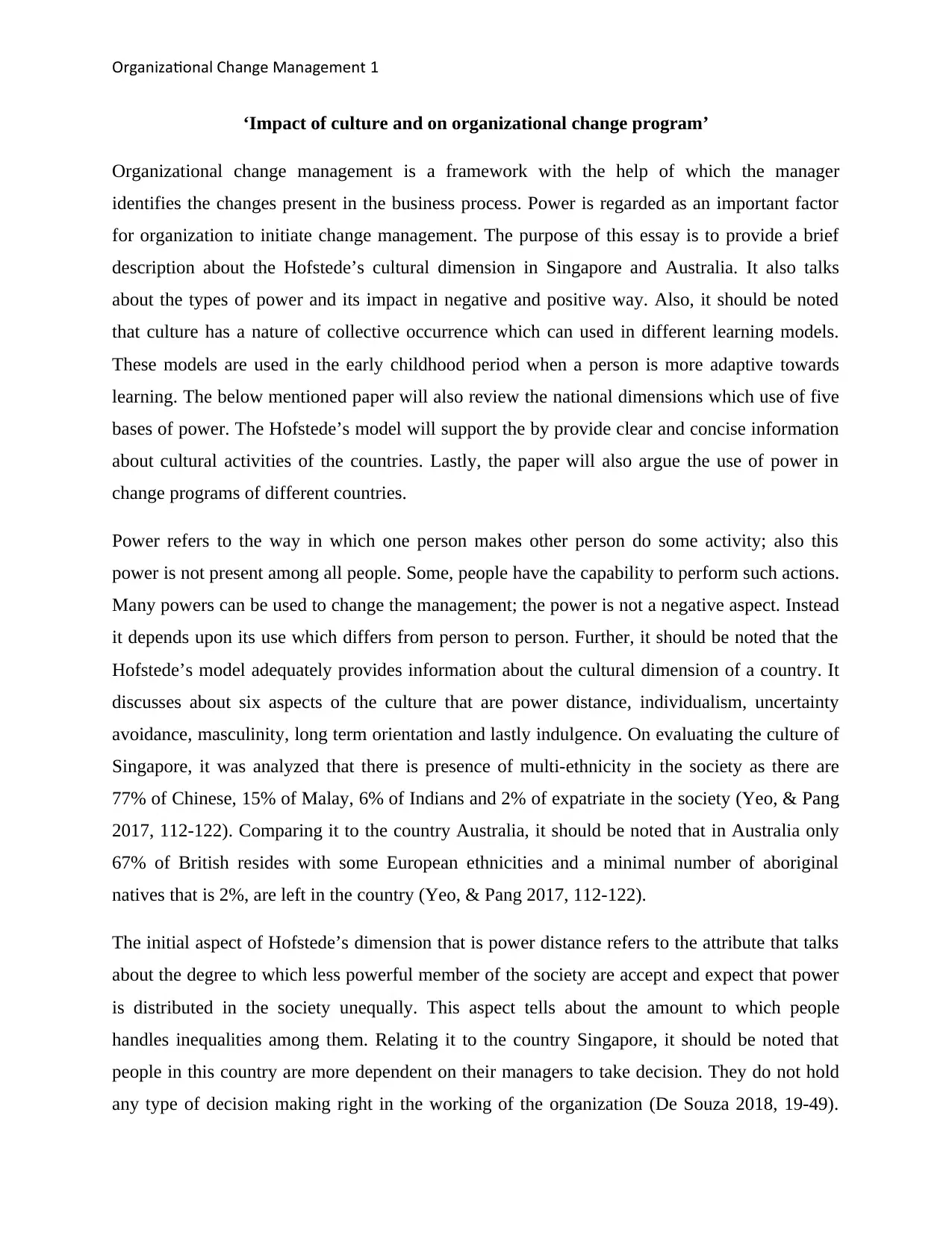
Organizational Change Management 1
‘Impact of culture and on organizational change program’
Organizational change management is a framework with the help of which the manager
identifies the changes present in the business process. Power is regarded as an important factor
for organization to initiate change management. The purpose of this essay is to provide a brief
description about the Hofstede’s cultural dimension in Singapore and Australia. It also talks
about the types of power and its impact in negative and positive way. Also, it should be noted
that culture has a nature of collective occurrence which can used in different learning models.
These models are used in the early childhood period when a person is more adaptive towards
learning. The below mentioned paper will also review the national dimensions which use of five
bases of power. The Hofstede’s model will support the by provide clear and concise information
about cultural activities of the countries. Lastly, the paper will also argue the use of power in
change programs of different countries.
Power refers to the way in which one person makes other person do some activity; also this
power is not present among all people. Some, people have the capability to perform such actions.
Many powers can be used to change the management; the power is not a negative aspect. Instead
it depends upon its use which differs from person to person. Further, it should be noted that the
Hofstede’s model adequately provides information about the cultural dimension of a country. It
discusses about six aspects of the culture that are power distance, individualism, uncertainty
avoidance, masculinity, long term orientation and lastly indulgence. On evaluating the culture of
Singapore, it was analyzed that there is presence of multi-ethnicity in the society as there are
77% of Chinese, 15% of Malay, 6% of Indians and 2% of expatriate in the society (Yeo, & Pang
2017, 112-122). Comparing it to the country Australia, it should be noted that in Australia only
67% of British resides with some European ethnicities and a minimal number of aboriginal
natives that is 2%, are left in the country (Yeo, & Pang 2017, 112-122).
The initial aspect of Hofstede’s dimension that is power distance refers to the attribute that talks
about the degree to which less powerful member of the society are accept and expect that power
is distributed in the society unequally. This aspect tells about the amount to which people
handles inequalities among them. Relating it to the country Singapore, it should be noted that
people in this country are more dependent on their managers to take decision. They do not hold
any type of decision making right in the working of the organization (De Souza 2018, 19-49).
‘Impact of culture and on organizational change program’
Organizational change management is a framework with the help of which the manager
identifies the changes present in the business process. Power is regarded as an important factor
for organization to initiate change management. The purpose of this essay is to provide a brief
description about the Hofstede’s cultural dimension in Singapore and Australia. It also talks
about the types of power and its impact in negative and positive way. Also, it should be noted
that culture has a nature of collective occurrence which can used in different learning models.
These models are used in the early childhood period when a person is more adaptive towards
learning. The below mentioned paper will also review the national dimensions which use of five
bases of power. The Hofstede’s model will support the by provide clear and concise information
about cultural activities of the countries. Lastly, the paper will also argue the use of power in
change programs of different countries.
Power refers to the way in which one person makes other person do some activity; also this
power is not present among all people. Some, people have the capability to perform such actions.
Many powers can be used to change the management; the power is not a negative aspect. Instead
it depends upon its use which differs from person to person. Further, it should be noted that the
Hofstede’s model adequately provides information about the cultural dimension of a country. It
discusses about six aspects of the culture that are power distance, individualism, uncertainty
avoidance, masculinity, long term orientation and lastly indulgence. On evaluating the culture of
Singapore, it was analyzed that there is presence of multi-ethnicity in the society as there are
77% of Chinese, 15% of Malay, 6% of Indians and 2% of expatriate in the society (Yeo, & Pang
2017, 112-122). Comparing it to the country Australia, it should be noted that in Australia only
67% of British resides with some European ethnicities and a minimal number of aboriginal
natives that is 2%, are left in the country (Yeo, & Pang 2017, 112-122).
The initial aspect of Hofstede’s dimension that is power distance refers to the attribute that talks
about the degree to which less powerful member of the society are accept and expect that power
is distributed in the society unequally. This aspect tells about the amount to which people
handles inequalities among them. Relating it to the country Singapore, it should be noted that
people in this country are more dependent on their managers to take decision. They do not hold
any type of decision making right in the working of the organization (De Souza 2018, 19-49).
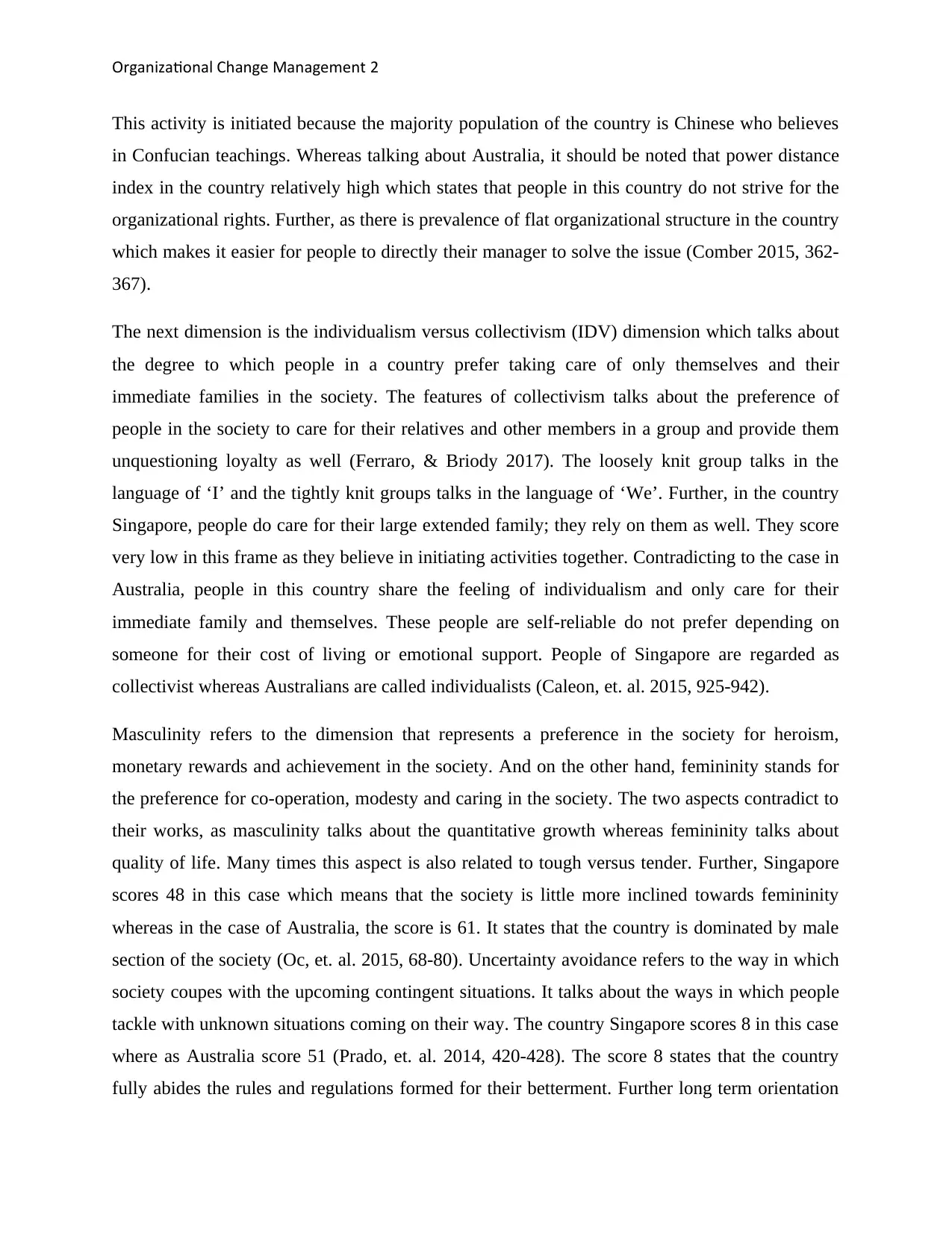
Organizational Change Management 2
This activity is initiated because the majority population of the country is Chinese who believes
in Confucian teachings. Whereas talking about Australia, it should be noted that power distance
index in the country relatively high which states that people in this country do not strive for the
organizational rights. Further, as there is prevalence of flat organizational structure in the country
which makes it easier for people to directly their manager to solve the issue (Comber 2015, 362-
367).
The next dimension is the individualism versus collectivism (IDV) dimension which talks about
the degree to which people in a country prefer taking care of only themselves and their
immediate families in the society. The features of collectivism talks about the preference of
people in the society to care for their relatives and other members in a group and provide them
unquestioning loyalty as well (Ferraro, & Briody 2017). The loosely knit group talks in the
language of ‘I’ and the tightly knit groups talks in the language of ‘We’. Further, in the country
Singapore, people do care for their large extended family; they rely on them as well. They score
very low in this frame as they believe in initiating activities together. Contradicting to the case in
Australia, people in this country share the feeling of individualism and only care for their
immediate family and themselves. These people are self-reliable do not prefer depending on
someone for their cost of living or emotional support. People of Singapore are regarded as
collectivist whereas Australians are called individualists (Caleon, et. al. 2015, 925-942).
Masculinity refers to the dimension that represents a preference in the society for heroism,
monetary rewards and achievement in the society. And on the other hand, femininity stands for
the preference for co-operation, modesty and caring in the society. The two aspects contradict to
their works, as masculinity talks about the quantitative growth whereas femininity talks about
quality of life. Many times this aspect is also related to tough versus tender. Further, Singapore
scores 48 in this case which means that the society is little more inclined towards femininity
whereas in the case of Australia, the score is 61. It states that the country is dominated by male
section of the society (Oc, et. al. 2015, 68-80). Uncertainty avoidance refers to the way in which
society coupes with the upcoming contingent situations. It talks about the ways in which people
tackle with unknown situations coming on their way. The country Singapore scores 8 in this case
where as Australia score 51 (Prado, et. al. 2014, 420-428). The score 8 states that the country
fully abides the rules and regulations formed for their betterment. Further long term orientation
This activity is initiated because the majority population of the country is Chinese who believes
in Confucian teachings. Whereas talking about Australia, it should be noted that power distance
index in the country relatively high which states that people in this country do not strive for the
organizational rights. Further, as there is prevalence of flat organizational structure in the country
which makes it easier for people to directly their manager to solve the issue (Comber 2015, 362-
367).
The next dimension is the individualism versus collectivism (IDV) dimension which talks about
the degree to which people in a country prefer taking care of only themselves and their
immediate families in the society. The features of collectivism talks about the preference of
people in the society to care for their relatives and other members in a group and provide them
unquestioning loyalty as well (Ferraro, & Briody 2017). The loosely knit group talks in the
language of ‘I’ and the tightly knit groups talks in the language of ‘We’. Further, in the country
Singapore, people do care for their large extended family; they rely on them as well. They score
very low in this frame as they believe in initiating activities together. Contradicting to the case in
Australia, people in this country share the feeling of individualism and only care for their
immediate family and themselves. These people are self-reliable do not prefer depending on
someone for their cost of living or emotional support. People of Singapore are regarded as
collectivist whereas Australians are called individualists (Caleon, et. al. 2015, 925-942).
Masculinity refers to the dimension that represents a preference in the society for heroism,
monetary rewards and achievement in the society. And on the other hand, femininity stands for
the preference for co-operation, modesty and caring in the society. The two aspects contradict to
their works, as masculinity talks about the quantitative growth whereas femininity talks about
quality of life. Many times this aspect is also related to tough versus tender. Further, Singapore
scores 48 in this case which means that the society is little more inclined towards femininity
whereas in the case of Australia, the score is 61. It states that the country is dominated by male
section of the society (Oc, et. al. 2015, 68-80). Uncertainty avoidance refers to the way in which
society coupes with the upcoming contingent situations. It talks about the ways in which people
tackle with unknown situations coming on their way. The country Singapore scores 8 in this case
where as Australia score 51 (Prado, et. al. 2014, 420-428). The score 8 states that the country
fully abides the rules and regulations formed for their betterment. Further long term orientation
⊘ This is a preview!⊘
Do you want full access?
Subscribe today to unlock all pages.

Trusted by 1+ million students worldwide
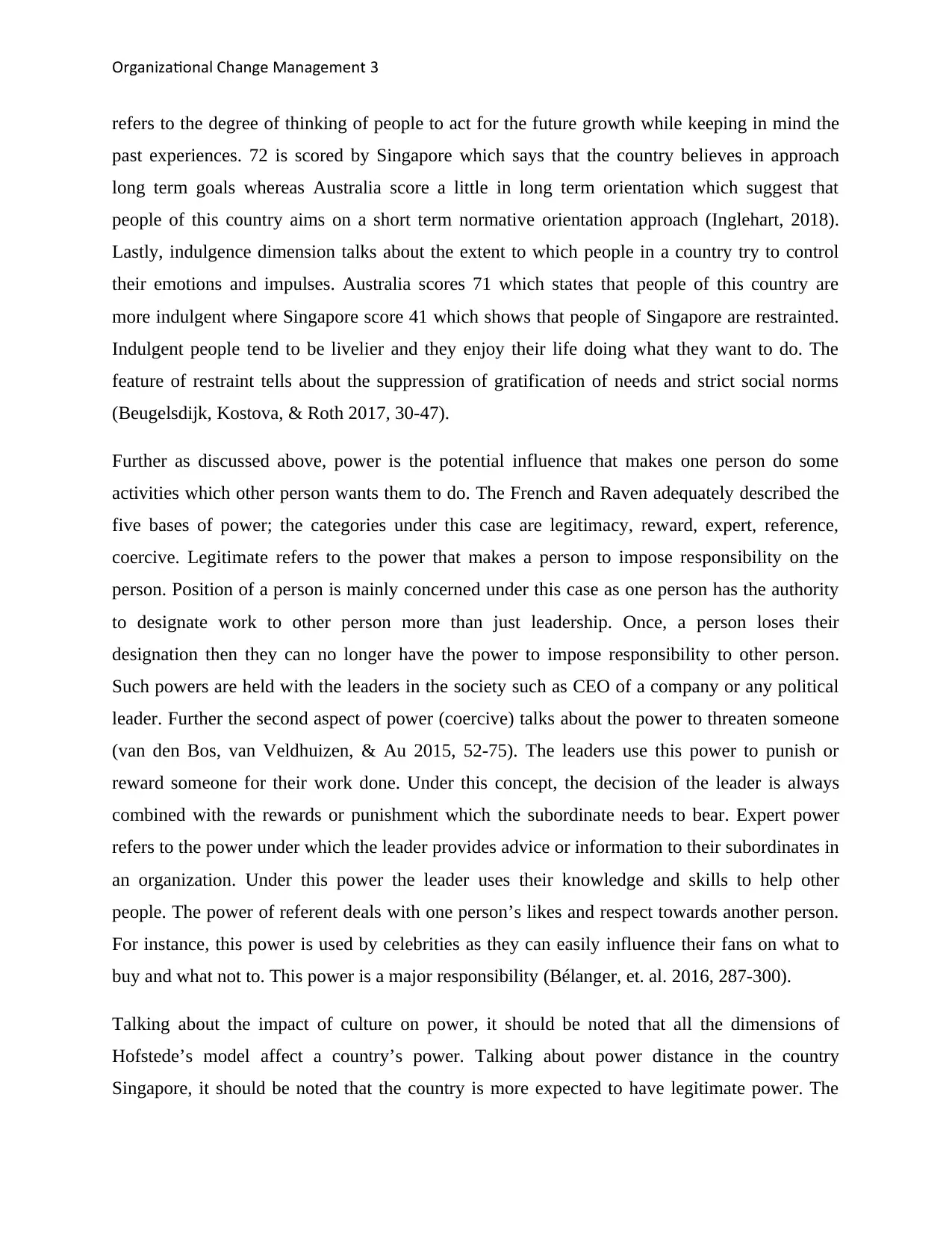
Organizational Change Management 3
refers to the degree of thinking of people to act for the future growth while keeping in mind the
past experiences. 72 is scored by Singapore which says that the country believes in approach
long term goals whereas Australia score a little in long term orientation which suggest that
people of this country aims on a short term normative orientation approach (Inglehart, 2018).
Lastly, indulgence dimension talks about the extent to which people in a country try to control
their emotions and impulses. Australia scores 71 which states that people of this country are
more indulgent where Singapore score 41 which shows that people of Singapore are restrainted.
Indulgent people tend to be livelier and they enjoy their life doing what they want to do. The
feature of restraint tells about the suppression of gratification of needs and strict social norms
(Beugelsdijk, Kostova, & Roth 2017, 30-47).
Further as discussed above, power is the potential influence that makes one person do some
activities which other person wants them to do. The French and Raven adequately described the
five bases of power; the categories under this case are legitimacy, reward, expert, reference,
coercive. Legitimate refers to the power that makes a person to impose responsibility on the
person. Position of a person is mainly concerned under this case as one person has the authority
to designate work to other person more than just leadership. Once, a person loses their
designation then they can no longer have the power to impose responsibility to other person.
Such powers are held with the leaders in the society such as CEO of a company or any political
leader. Further the second aspect of power (coercive) talks about the power to threaten someone
(van den Bos, van Veldhuizen, & Au 2015, 52-75). The leaders use this power to punish or
reward someone for their work done. Under this concept, the decision of the leader is always
combined with the rewards or punishment which the subordinate needs to bear. Expert power
refers to the power under which the leader provides advice or information to their subordinates in
an organization. Under this power the leader uses their knowledge and skills to help other
people. The power of referent deals with one person’s likes and respect towards another person.
For instance, this power is used by celebrities as they can easily influence their fans on what to
buy and what not to. This power is a major responsibility (Bélanger, et. al. 2016, 287-300).
Talking about the impact of culture on power, it should be noted that all the dimensions of
Hofstede’s model affect a country’s power. Talking about power distance in the country
Singapore, it should be noted that the country is more expected to have legitimate power. The
refers to the degree of thinking of people to act for the future growth while keeping in mind the
past experiences. 72 is scored by Singapore which says that the country believes in approach
long term goals whereas Australia score a little in long term orientation which suggest that
people of this country aims on a short term normative orientation approach (Inglehart, 2018).
Lastly, indulgence dimension talks about the extent to which people in a country try to control
their emotions and impulses. Australia scores 71 which states that people of this country are
more indulgent where Singapore score 41 which shows that people of Singapore are restrainted.
Indulgent people tend to be livelier and they enjoy their life doing what they want to do. The
feature of restraint tells about the suppression of gratification of needs and strict social norms
(Beugelsdijk, Kostova, & Roth 2017, 30-47).
Further as discussed above, power is the potential influence that makes one person do some
activities which other person wants them to do. The French and Raven adequately described the
five bases of power; the categories under this case are legitimacy, reward, expert, reference,
coercive. Legitimate refers to the power that makes a person to impose responsibility on the
person. Position of a person is mainly concerned under this case as one person has the authority
to designate work to other person more than just leadership. Once, a person loses their
designation then they can no longer have the power to impose responsibility to other person.
Such powers are held with the leaders in the society such as CEO of a company or any political
leader. Further the second aspect of power (coercive) talks about the power to threaten someone
(van den Bos, van Veldhuizen, & Au 2015, 52-75). The leaders use this power to punish or
reward someone for their work done. Under this concept, the decision of the leader is always
combined with the rewards or punishment which the subordinate needs to bear. Expert power
refers to the power under which the leader provides advice or information to their subordinates in
an organization. Under this power the leader uses their knowledge and skills to help other
people. The power of referent deals with one person’s likes and respect towards another person.
For instance, this power is used by celebrities as they can easily influence their fans on what to
buy and what not to. This power is a major responsibility (Bélanger, et. al. 2016, 287-300).
Talking about the impact of culture on power, it should be noted that all the dimensions of
Hofstede’s model affect a country’s power. Talking about power distance in the country
Singapore, it should be noted that the country is more expected to have legitimate power. The
Paraphrase This Document
Need a fresh take? Get an instant paraphrase of this document with our AI Paraphraser

Organizational Change Management 4
country uses such type of power because there is high degree of power distance in the country.
Whereas, on the other hand, as Australia has a low score in this case so this country uses the
power of expert or referent. Australia uses this type of power because there is presence of people
who aim for equality in the society. Experts of the society are he king pin that molds the
activities of an organization present in the market (Bélanger, et. al. 2015, 25-43). Also, the
country Australia is an individualistic country, so the employees of country have to act
economically so as to maintain the cost of living themselves; further, a mutual interest is
maintain between the employees and the mangers present in the society. Thus, it should be noted
that the expert feature adequately supports the cultural activities of the country, as an
individualistic country which makes the manager to initiate their power in such a way that it
provide assistance to the employee to maintain their daily activities (Aiello, Tesi, Pratto, &
Pierro 2018). The power of expert helps the management to easily solve the critical problems in
the organization and help the employees as well. Apart from that, talking about the country
Singapore, it should be noted that the country is a strong belief of collectivist society where all
relatives live together and support each other with their daily routine activities. Resulting which
the power of legitimate would adequately work in the society. The legitimate power works
according to the social hierarchical ways and according to the cultural norms. Under this case,
the organizational structure provides the power to the leaders to enact different activities in an
organization. The leaders under this case have full right to impose responsibilities or oblige the
employees according to work issued to them. Relating the case of legitimate power with the
collectivist culture of the society it should be noted that as the people of this country are
dependent on their superiors which initiates them to agree on the restrictions imposed on them
(Liu, & Almor 2016, 4-14).
In order to implement a change in an organization, the most important feature which is required
is power as without adequate power no leader can make their decision effective in an
organization. Organizational change management refers to the framework that deals with the
process of change initiated in an organization for the good. Power is the only thing that influence
people in an organization and motivate them to follow the change as well. The change manager
process is initiated by the CEO of the company, manager, leader, board members etc. Further, as
discussed above there are many bases in which the power used in an organization is
differentiated. It wholly and solely depends upon the culture of an organization according to
country uses such type of power because there is high degree of power distance in the country.
Whereas, on the other hand, as Australia has a low score in this case so this country uses the
power of expert or referent. Australia uses this type of power because there is presence of people
who aim for equality in the society. Experts of the society are he king pin that molds the
activities of an organization present in the market (Bélanger, et. al. 2015, 25-43). Also, the
country Australia is an individualistic country, so the employees of country have to act
economically so as to maintain the cost of living themselves; further, a mutual interest is
maintain between the employees and the mangers present in the society. Thus, it should be noted
that the expert feature adequately supports the cultural activities of the country, as an
individualistic country which makes the manager to initiate their power in such a way that it
provide assistance to the employee to maintain their daily activities (Aiello, Tesi, Pratto, &
Pierro 2018). The power of expert helps the management to easily solve the critical problems in
the organization and help the employees as well. Apart from that, talking about the country
Singapore, it should be noted that the country is a strong belief of collectivist society where all
relatives live together and support each other with their daily routine activities. Resulting which
the power of legitimate would adequately work in the society. The legitimate power works
according to the social hierarchical ways and according to the cultural norms. Under this case,
the organizational structure provides the power to the leaders to enact different activities in an
organization. The leaders under this case have full right to impose responsibilities or oblige the
employees according to work issued to them. Relating the case of legitimate power with the
collectivist culture of the society it should be noted that as the people of this country are
dependent on their superiors which initiates them to agree on the restrictions imposed on them
(Liu, & Almor 2016, 4-14).
In order to implement a change in an organization, the most important feature which is required
is power as without adequate power no leader can make their decision effective in an
organization. Organizational change management refers to the framework that deals with the
process of change initiated in an organization for the good. Power is the only thing that influence
people in an organization and motivate them to follow the change as well. The change manager
process is initiated by the CEO of the company, manager, leader, board members etc. Further, as
discussed above there are many bases in which the power used in an organization is
differentiated. It wholly and solely depends upon the culture of an organization according to
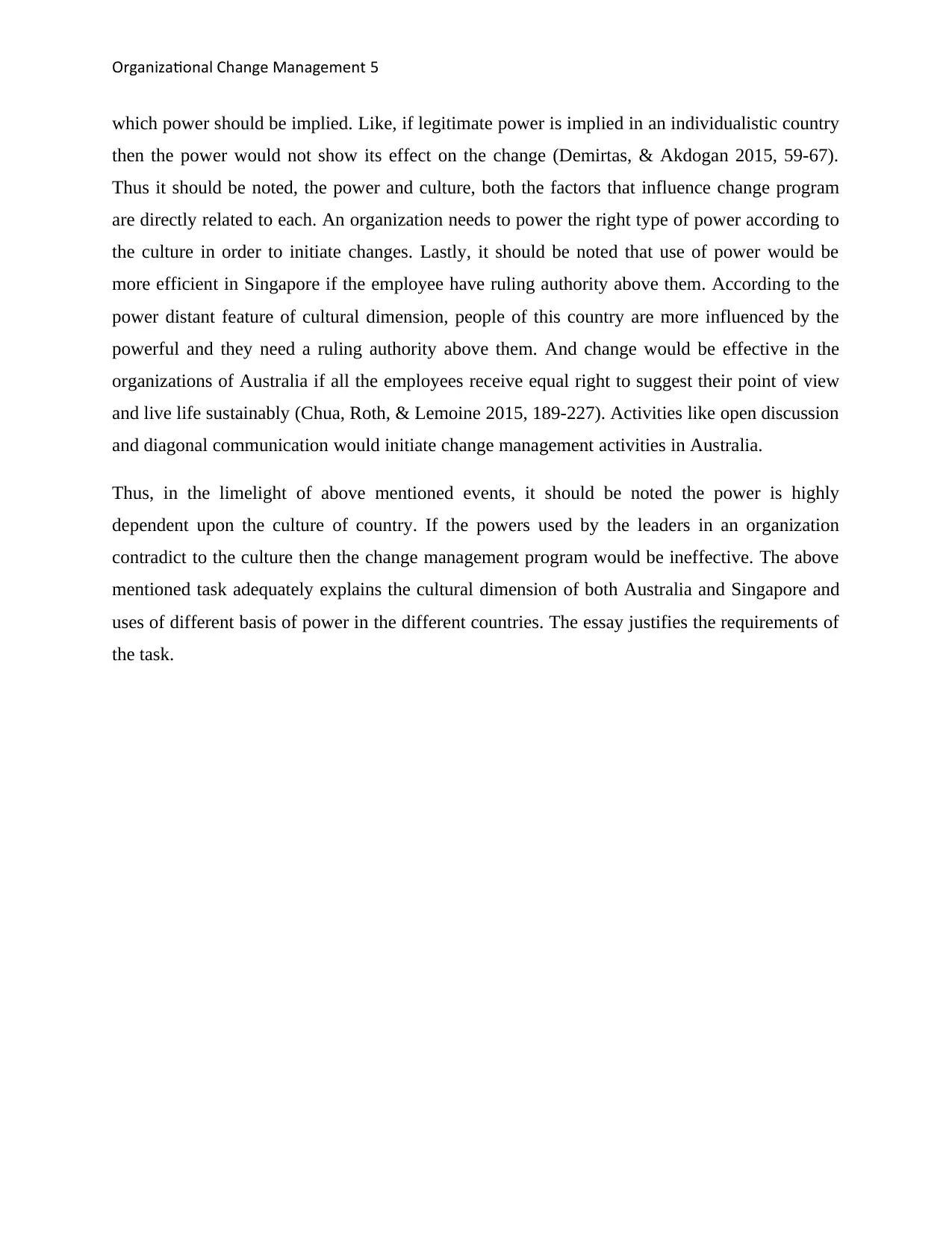
Organizational Change Management 5
which power should be implied. Like, if legitimate power is implied in an individualistic country
then the power would not show its effect on the change (Demirtas, & Akdogan 2015, 59-67).
Thus it should be noted, the power and culture, both the factors that influence change program
are directly related to each. An organization needs to power the right type of power according to
the culture in order to initiate changes. Lastly, it should be noted that use of power would be
more efficient in Singapore if the employee have ruling authority above them. According to the
power distant feature of cultural dimension, people of this country are more influenced by the
powerful and they need a ruling authority above them. And change would be effective in the
organizations of Australia if all the employees receive equal right to suggest their point of view
and live life sustainably (Chua, Roth, & Lemoine 2015, 189-227). Activities like open discussion
and diagonal communication would initiate change management activities in Australia.
Thus, in the limelight of above mentioned events, it should be noted the power is highly
dependent upon the culture of country. If the powers used by the leaders in an organization
contradict to the culture then the change management program would be ineffective. The above
mentioned task adequately explains the cultural dimension of both Australia and Singapore and
uses of different basis of power in the different countries. The essay justifies the requirements of
the task.
which power should be implied. Like, if legitimate power is implied in an individualistic country
then the power would not show its effect on the change (Demirtas, & Akdogan 2015, 59-67).
Thus it should be noted, the power and culture, both the factors that influence change program
are directly related to each. An organization needs to power the right type of power according to
the culture in order to initiate changes. Lastly, it should be noted that use of power would be
more efficient in Singapore if the employee have ruling authority above them. According to the
power distant feature of cultural dimension, people of this country are more influenced by the
powerful and they need a ruling authority above them. And change would be effective in the
organizations of Australia if all the employees receive equal right to suggest their point of view
and live life sustainably (Chua, Roth, & Lemoine 2015, 189-227). Activities like open discussion
and diagonal communication would initiate change management activities in Australia.
Thus, in the limelight of above mentioned events, it should be noted the power is highly
dependent upon the culture of country. If the powers used by the leaders in an organization
contradict to the culture then the change management program would be ineffective. The above
mentioned task adequately explains the cultural dimension of both Australia and Singapore and
uses of different basis of power in the different countries. The essay justifies the requirements of
the task.
⊘ This is a preview!⊘
Do you want full access?
Subscribe today to unlock all pages.

Trusted by 1+ million students worldwide
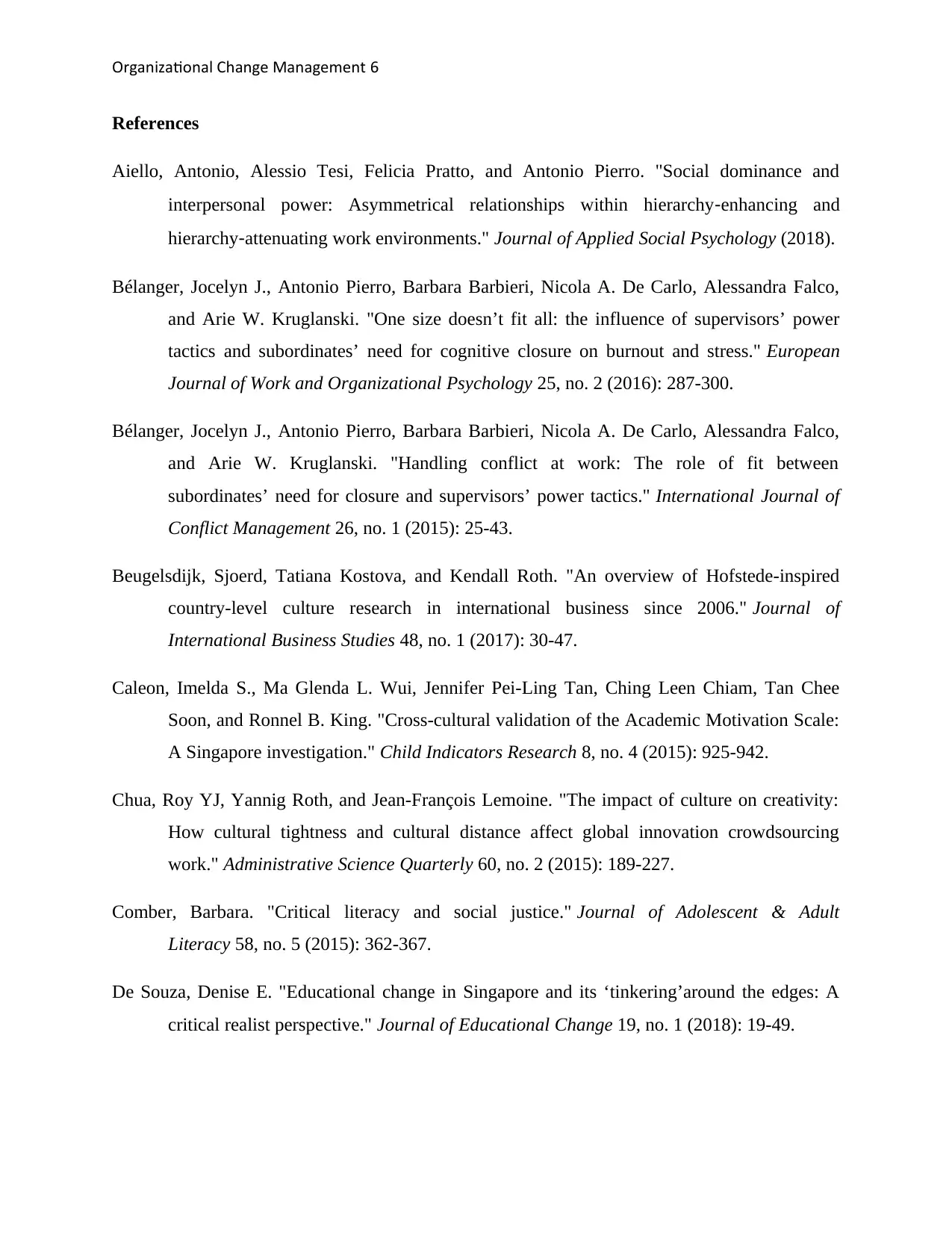
Organizational Change Management 6
References
Aiello, Antonio, Alessio Tesi, Felicia Pratto, and Antonio Pierro. "Social dominance and
interpersonal power: Asymmetrical relationships within hierarchy‐enhancing and
hierarchy‐attenuating work environments." Journal of Applied Social Psychology (2018).
Bélanger, Jocelyn J., Antonio Pierro, Barbara Barbieri, Nicola A. De Carlo, Alessandra Falco,
and Arie W. Kruglanski. "One size doesn’t fit all: the influence of supervisors’ power
tactics and subordinates’ need for cognitive closure on burnout and stress." European
Journal of Work and Organizational Psychology 25, no. 2 (2016): 287-300.
Bélanger, Jocelyn J., Antonio Pierro, Barbara Barbieri, Nicola A. De Carlo, Alessandra Falco,
and Arie W. Kruglanski. "Handling conflict at work: The role of fit between
subordinates’ need for closure and supervisors’ power tactics." International Journal of
Conflict Management 26, no. 1 (2015): 25-43.
Beugelsdijk, Sjoerd, Tatiana Kostova, and Kendall Roth. "An overview of Hofstede-inspired
country-level culture research in international business since 2006." Journal of
International Business Studies 48, no. 1 (2017): 30-47.
Caleon, Imelda S., Ma Glenda L. Wui, Jennifer Pei-Ling Tan, Ching Leen Chiam, Tan Chee
Soon, and Ronnel B. King. "Cross-cultural validation of the Academic Motivation Scale:
A Singapore investigation." Child Indicators Research 8, no. 4 (2015): 925-942.
Chua, Roy YJ, Yannig Roth, and Jean-François Lemoine. "The impact of culture on creativity:
How cultural tightness and cultural distance affect global innovation crowdsourcing
work." Administrative Science Quarterly 60, no. 2 (2015): 189-227.
Comber, Barbara. "Critical literacy and social justice." Journal of Adolescent & Adult
Literacy 58, no. 5 (2015): 362-367.
De Souza, Denise E. "Educational change in Singapore and its ‘tinkering’around the edges: A
critical realist perspective." Journal of Educational Change 19, no. 1 (2018): 19-49.
References
Aiello, Antonio, Alessio Tesi, Felicia Pratto, and Antonio Pierro. "Social dominance and
interpersonal power: Asymmetrical relationships within hierarchy‐enhancing and
hierarchy‐attenuating work environments." Journal of Applied Social Psychology (2018).
Bélanger, Jocelyn J., Antonio Pierro, Barbara Barbieri, Nicola A. De Carlo, Alessandra Falco,
and Arie W. Kruglanski. "One size doesn’t fit all: the influence of supervisors’ power
tactics and subordinates’ need for cognitive closure on burnout and stress." European
Journal of Work and Organizational Psychology 25, no. 2 (2016): 287-300.
Bélanger, Jocelyn J., Antonio Pierro, Barbara Barbieri, Nicola A. De Carlo, Alessandra Falco,
and Arie W. Kruglanski. "Handling conflict at work: The role of fit between
subordinates’ need for closure and supervisors’ power tactics." International Journal of
Conflict Management 26, no. 1 (2015): 25-43.
Beugelsdijk, Sjoerd, Tatiana Kostova, and Kendall Roth. "An overview of Hofstede-inspired
country-level culture research in international business since 2006." Journal of
International Business Studies 48, no. 1 (2017): 30-47.
Caleon, Imelda S., Ma Glenda L. Wui, Jennifer Pei-Ling Tan, Ching Leen Chiam, Tan Chee
Soon, and Ronnel B. King. "Cross-cultural validation of the Academic Motivation Scale:
A Singapore investigation." Child Indicators Research 8, no. 4 (2015): 925-942.
Chua, Roy YJ, Yannig Roth, and Jean-François Lemoine. "The impact of culture on creativity:
How cultural tightness and cultural distance affect global innovation crowdsourcing
work." Administrative Science Quarterly 60, no. 2 (2015): 189-227.
Comber, Barbara. "Critical literacy and social justice." Journal of Adolescent & Adult
Literacy 58, no. 5 (2015): 362-367.
De Souza, Denise E. "Educational change in Singapore and its ‘tinkering’around the edges: A
critical realist perspective." Journal of Educational Change 19, no. 1 (2018): 19-49.
Paraphrase This Document
Need a fresh take? Get an instant paraphrase of this document with our AI Paraphraser
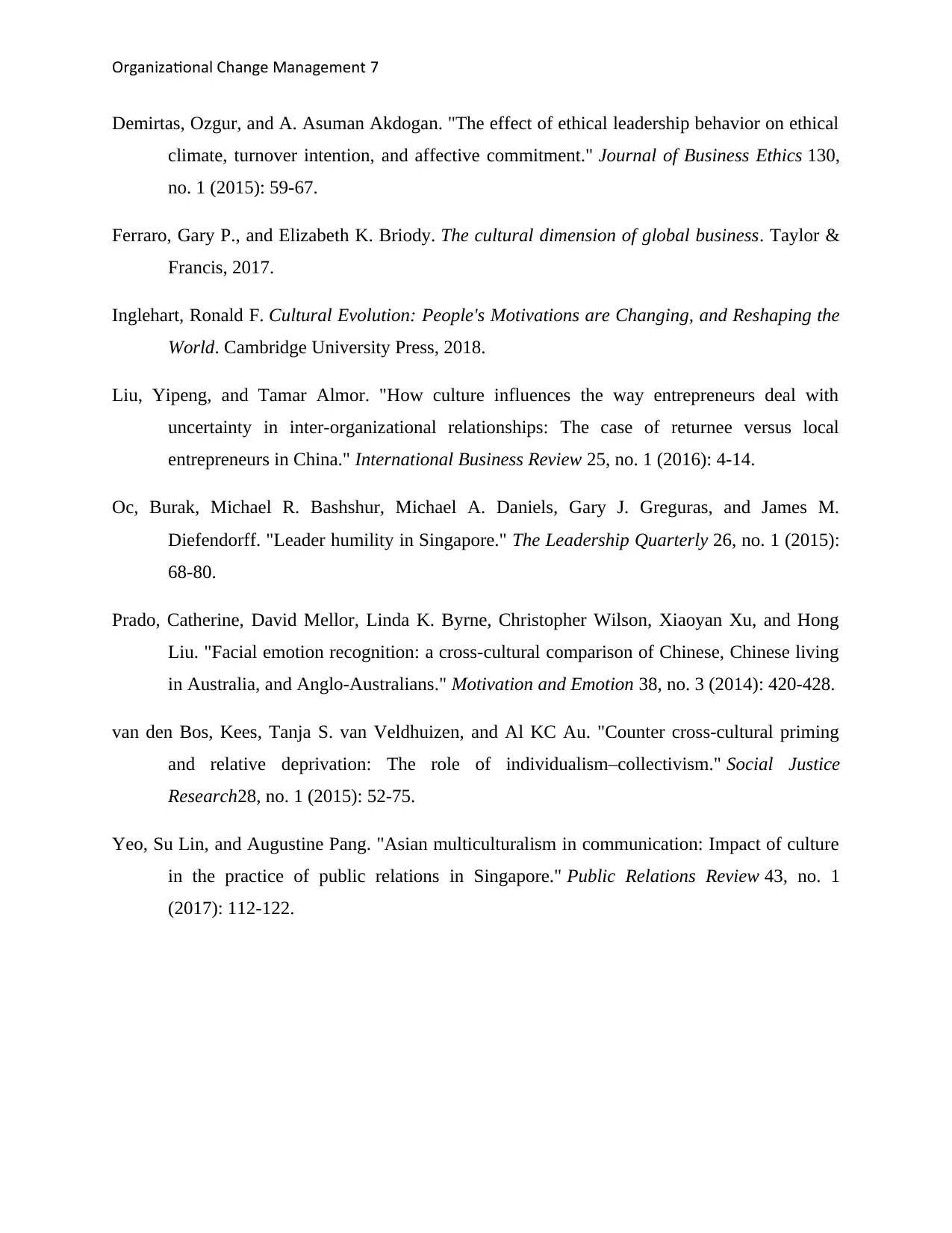
Organizational Change Management 7
Demirtas, Ozgur, and A. Asuman Akdogan. "The effect of ethical leadership behavior on ethical
climate, turnover intention, and affective commitment." Journal of Business Ethics 130,
no. 1 (2015): 59-67.
Ferraro, Gary P., and Elizabeth K. Briody. The cultural dimension of global business. Taylor &
Francis, 2017.
Inglehart, Ronald F. Cultural Evolution: People's Motivations are Changing, and Reshaping the
World. Cambridge University Press, 2018.
Liu, Yipeng, and Tamar Almor. "How culture influences the way entrepreneurs deal with
uncertainty in inter-organizational relationships: The case of returnee versus local
entrepreneurs in China." International Business Review 25, no. 1 (2016): 4-14.
Oc, Burak, Michael R. Bashshur, Michael A. Daniels, Gary J. Greguras, and James M.
Diefendorff. "Leader humility in Singapore." The Leadership Quarterly 26, no. 1 (2015):
68-80.
Prado, Catherine, David Mellor, Linda K. Byrne, Christopher Wilson, Xiaoyan Xu, and Hong
Liu. "Facial emotion recognition: a cross-cultural comparison of Chinese, Chinese living
in Australia, and Anglo-Australians." Motivation and Emotion 38, no. 3 (2014): 420-428.
van den Bos, Kees, Tanja S. van Veldhuizen, and Al KC Au. "Counter cross-cultural priming
and relative deprivation: The role of individualism–collectivism." Social Justice
Research28, no. 1 (2015): 52-75.
Yeo, Su Lin, and Augustine Pang. "Asian multiculturalism in communication: Impact of culture
in the practice of public relations in Singapore." Public Relations Review 43, no. 1
(2017): 112-122.
Demirtas, Ozgur, and A. Asuman Akdogan. "The effect of ethical leadership behavior on ethical
climate, turnover intention, and affective commitment." Journal of Business Ethics 130,
no. 1 (2015): 59-67.
Ferraro, Gary P., and Elizabeth K. Briody. The cultural dimension of global business. Taylor &
Francis, 2017.
Inglehart, Ronald F. Cultural Evolution: People's Motivations are Changing, and Reshaping the
World. Cambridge University Press, 2018.
Liu, Yipeng, and Tamar Almor. "How culture influences the way entrepreneurs deal with
uncertainty in inter-organizational relationships: The case of returnee versus local
entrepreneurs in China." International Business Review 25, no. 1 (2016): 4-14.
Oc, Burak, Michael R. Bashshur, Michael A. Daniels, Gary J. Greguras, and James M.
Diefendorff. "Leader humility in Singapore." The Leadership Quarterly 26, no. 1 (2015):
68-80.
Prado, Catherine, David Mellor, Linda K. Byrne, Christopher Wilson, Xiaoyan Xu, and Hong
Liu. "Facial emotion recognition: a cross-cultural comparison of Chinese, Chinese living
in Australia, and Anglo-Australians." Motivation and Emotion 38, no. 3 (2014): 420-428.
van den Bos, Kees, Tanja S. van Veldhuizen, and Al KC Au. "Counter cross-cultural priming
and relative deprivation: The role of individualism–collectivism." Social Justice
Research28, no. 1 (2015): 52-75.
Yeo, Su Lin, and Augustine Pang. "Asian multiculturalism in communication: Impact of culture
in the practice of public relations in Singapore." Public Relations Review 43, no. 1
(2017): 112-122.
1 out of 8
Related Documents
Your All-in-One AI-Powered Toolkit for Academic Success.
+13062052269
info@desklib.com
Available 24*7 on WhatsApp / Email
![[object Object]](/_next/static/media/star-bottom.7253800d.svg)
Unlock your academic potential
Copyright © 2020–2025 A2Z Services. All Rights Reserved. Developed and managed by ZUCOL.





